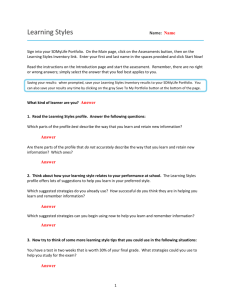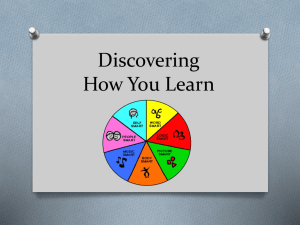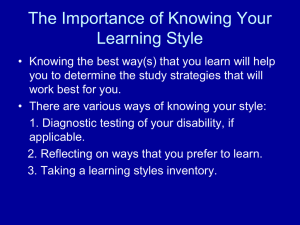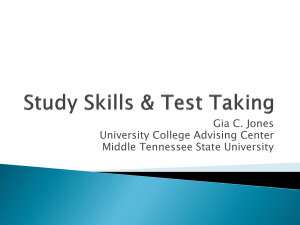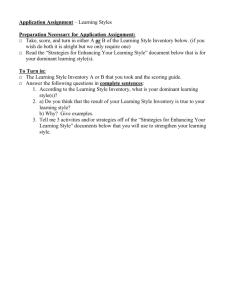Learning Style Inventory and Synopsis
advertisement
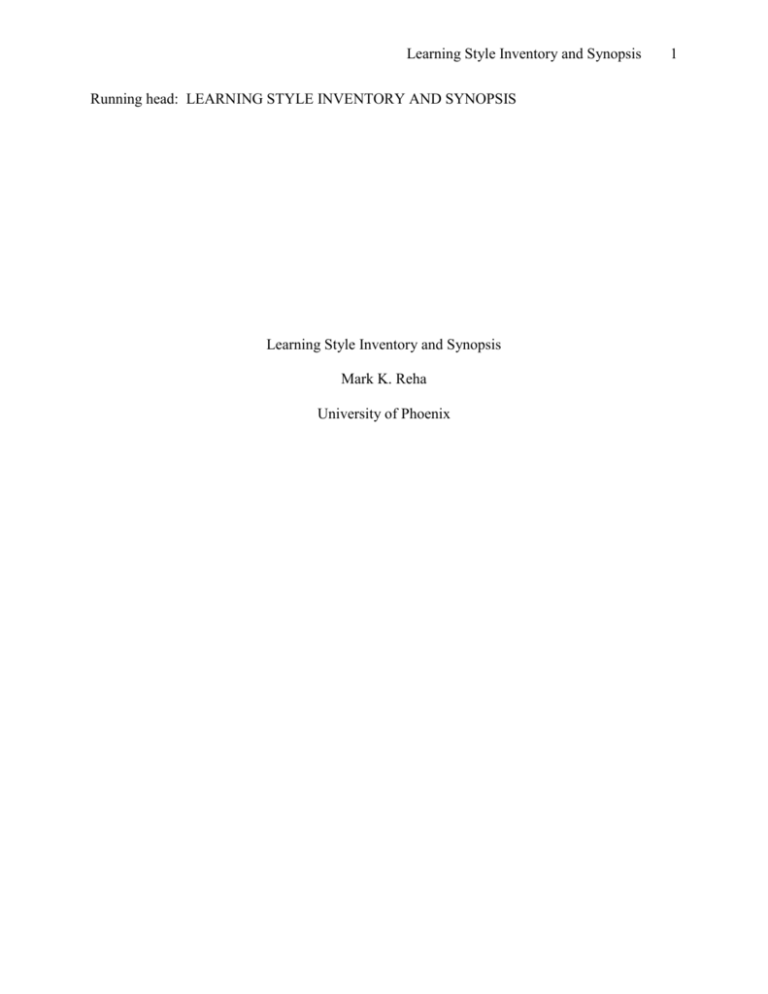
Learning Style Inventory and Synopsis Running head: LEARNING STYLE INVENTORY AND SYNOPSIS Learning Style Inventory and Synopsis Mark K. Reha University of Phoenix 1 Learning Style Inventory and Synopsis 2 Learning Style Inventory and Synopsis This paper introduces the reader to a learning style model, then provides a personal inventory of the authors learning styles, and identifies an online resource in which a learning style test was taken. The paper concluded by analyzing the results of the learning style test and how this learning style has influenced my facilitation style in a professional setting. Historically, at least 80 learning style models have been proposed, each consisting of at least two different learning styles. One of the most common and widely used models is the Fleming's VARK learning style model. The VARK learning style model includes (a) visual learners, (b) auditory learners, (c) reading/writing-preference learners, and (d) kinesthetic learners or tactile learners. Visual learners learn through seeing. Teaching to visual learners, which make up to 65% of the population, can be achieved by using pictures, overhead slides, diagrams, handouts, and other visual aids. A few of the common traits of a visual learner include the love of books, magazines, and other reading materials. Visual learners also like to have a pen and paper handy and may grow frustrated and restless if they cannot take notes. Visual learners may have exceptional "photographic memories." Auditory learners learn through listening. Teaching to auditory learners, which make up to 30% of the population, can be achieved by using lectures, discussions, tapes, and other hearing aids. A few of the common traits of an auditory learner include being talkative in class, relate mostly to spoken word, benefit mostly from reading aloud, and enjoys talking to others. Reading and writing preference learners learn through words. These learners learn by reading and writing in all forms such as dictionaries and glossaries. A few of the common traits of reading/writing learners include preference to learn by reading or writing, turn diagrams or images into words, repeat ably read notes silently to themselves, and arranges Learning Style Inventory and Synopsis 3 words into hierarchies and points. Tactile or kinesthetic learners learn through experience. Teaching to tactile learners, which make up to 5% of the population, can be achieved by using tools, building models, manipulating things, emotions, touching, demonstrations, or by learning actively in some other way. A few of the common traits of a tactile include finding it difficult to sit for long periods, preferring to walk or use large motor muscles when learning, tends to collect things, does not have good hand writing, talks fast, and use their hands to communicate. To test the authors own learning styles an online learning style test available from MetaMath (Isakson, Carol and Jester, Catherine) was employed. The online learning style test was conducted using of a series of multiple-choice questions that measured the dependencies on visual, auditory, and tactile learning styles. The detailed results of the learning style tests are outlined in Appendix A and summarized as follows: Visual: primary learning style Auditory: secondary learning style Tactile: used sometimes as a learning style To analyze the results of the online learning style I first took an inventory of his interests, hobbies, and career to identify the expected learning skills used to learn hobbies and professional skills. This inventory was completed to see if the online VARK learning style test results had any correlation in how the author learned his interests and hobbies as an adult. Table 1 illustrates the expected learning styles for the author. Learning Style Inventory and Synopsis 4 Table 1. Adult Learning Styles Interest/Profession Music (Guitar) Expected Learning Style Visual and auditory Comments Music was learned through reading music books and listening to music. Beatles music was learned Music (Beatles) Visual and auditory through reading books and listening to their music. Sports were learned visually watching other teammates, Sports Visual and tactile listening to teammates, and by practicing drills. Software programming was learned visually by inspecting software programs, by reading Software programming Visual and tactile technical journals and books, and by writing actual programs. A computer was learned visually by inspecting Computers Visual and tactile computer hardware, by reading technical journals and books, and by building Learning Style Inventory and Synopsis 5 computers. These jobs were learned using visual artifacts like drawings Engineer/Architect/Manager Visual and auditory and by listening and by reading technical journals and books. The results of the online VARK tests show that the author’s strengths were his ability to learn equally by using both visual and auditory learning styles. The test results also indicated that the tactile learning style was not commonly used. The test results reflect that the author learned primary from the visual learning style by using pictures, overhead pictures, overhead slides, diagrams, handouts, and other visual aides, which all allow the author to envision a topic with his thoughts. Learning is best achieved when information is presented visually and is in a written language format. The test results also reflect that the author learned primary from the auditory learning style by listening to the words in lectures, discussions, tapes, and by participating through group discussions. Learning is best achieved when information is presented in an oral language format. The expected learning styles from the inventory were validated by the results of the VARK online learning style test but also showed that the tactile learning style was prominent in the inventory but scored the lowest on the online learning style test. Professionally, the author has benefited by using the strengths of his visual and auditory learning skills. As a software engineer and software architect pictures, overhead pictures, overhead slides, diagrams, handouts, and other visual aides are all commonly used to learn the skills required in my profession. As a director of software and engineering manager requires me Learning Style Inventory and Synopsis 6 to facilitate meeting, mentor younger engineers, and give presentations to executives. The author’s profession also requires a tremendous amount of reading to keep up with industry trends, industry standards, and obtain technical information. The authors’ job requires that he equally be able to communicate visually and audibly with team members. Visual communication is achieved through presentations and documents. Audible communication is achieved through meetings and training classes. Although the author learned equally by using both visual and auditory learning styles the author must keep in mind that there are other learning styles that potentially will be used by other peers in his professional setting. Learning Style Inventory and Synopsis References Drago, W. A., & Wagner, R. J. (2004). Vark Preferred Learning Styles and Online Education. Vol. 27(Issue. 7), pg 1. Retrieved July 31, 2010, from the ProQuest Database. Jester, C. (2010). A Learning Style Survey for College, Diablo Valley College. http://www.metamath.com/multiple/multiple_choice_questions.html. Retrieved July 31, 2010, from the Google Scholar. 7 Learning Style Inventory and Synopsis Appendix A: Learning Skill Online Test Results MetaMath Online Learning Skill test results: Visual and Nonverbal: 26 Visual and Verbal: 26 Auditory: 20 Kinesthetic: 20 8
